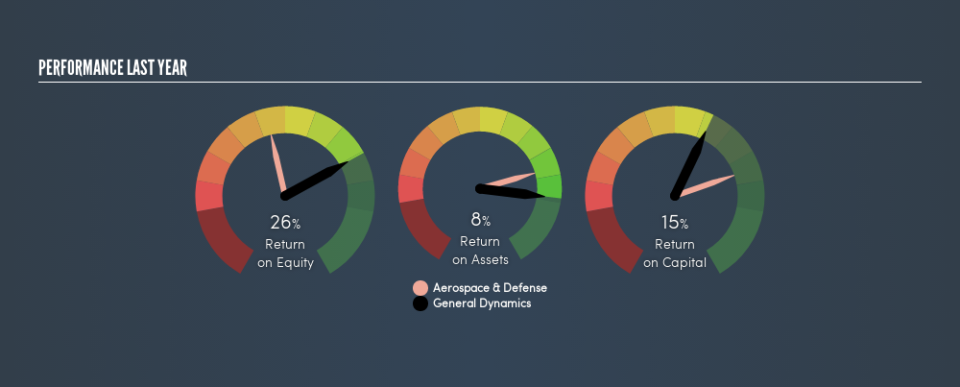Should You Like General Dynamics Corporation’s (NYSE:GD) High Return On Capital Employed?

Today we'll look at General Dynamics Corporation (NYSE:GD) and reflect on its potential as an investment. In particular, we'll consider its Return On Capital Employed (ROCE), as that can give us insight into how profitably the company is able to employ capital in its business.
Firstly, we'll go over how we calculate ROCE. Next, we'll compare it to others in its industry. And finally, we'll look at how its current liabilities are impacting its ROCE.
Return On Capital Employed (ROCE): What is it?
ROCE is a metric for evaluating how much pre-tax income (in percentage terms) a company earns on the capital invested in its business. In general, businesses with a higher ROCE are usually better quality. Overall, it is a valuable metric that has its flaws. Author Edwin Whiting says to be careful when comparing the ROCE of different businesses, since 'No two businesses are exactly alike.'
So, How Do We Calculate ROCE?
The formula for calculating the return on capital employed is:
Return on Capital Employed = Earnings Before Interest and Tax (EBIT) ÷ (Total Assets - Current Liabilities)
Or for General Dynamics:
0.15 = US$4.5b ÷ (US$48b - US$18b) (Based on the trailing twelve months to June 2019.)
So, General Dynamics has an ROCE of 15%.
Check out our latest analysis for General Dynamics
Does General Dynamics Have A Good ROCE?
One way to assess ROCE is to compare similar companies. General Dynamics's ROCE appears to be substantially greater than the 11% average in the Aerospace & Defense industry. I think that's good to see, since it implies the company is better than other companies at making the most of its capital. Regardless of where General Dynamics sits next to its industry, its ROCE in absolute terms appears satisfactory, and this company could be worth a closer look.
General Dynamics's current ROCE of 15% is lower than its ROCE in the past, which was 21%, 3 years ago. This makes us wonder if the business is facing new challenges. You can see in the image below how General Dynamics's ROCE compares to its industry. Click to see more on past growth.
When considering ROCE, bear in mind that it reflects the past and does not necessarily predict the future. Companies in cyclical industries can be difficult to understand using ROCE, as returns typically look high during boom times, and low during busts. ROCE is, after all, simply a snap shot of a single year. Since the future is so important for investors, you should check out our free report on analyst forecasts for General Dynamics.
General Dynamics's Current Liabilities And Their Impact On Its ROCE
Current liabilities include invoices, such as supplier payments, short-term debt, or a tax bill, that need to be paid within 12 months. The ROCE equation subtracts current liabilities from capital employed, so a company with a lot of current liabilities appears to have less capital employed, and a higher ROCE than otherwise. To counteract this, we check if a company has high current liabilities, relative to its total assets.
General Dynamics has total liabilities of US$18b and total assets of US$48b. Therefore its current liabilities are equivalent to approximately 37% of its total assets. General Dynamics has a middling amount of current liabilities, increasing its ROCE somewhat.
Our Take On General Dynamics's ROCE
General Dynamics's ROCE does look good, but the level of current liabilities also contribute to that. General Dynamics looks strong on this analysis, but there are plenty of other companies that could be a good opportunity . Here is a free list of companies growing earnings rapidly.
If you are like me, then you will not want to miss this free list of growing companies that insiders are buying.
We aim to bring you long-term focused research analysis driven by fundamental data. Note that our analysis may not factor in the latest price-sensitive company announcements or qualitative material.
If you spot an error that warrants correction, please contact the editor at editorial-team@simplywallst.com. This article by Simply Wall St is general in nature. It does not constitute a recommendation to buy or sell any stock, and does not take account of your objectives, or your financial situation. Simply Wall St has no position in the stocks mentioned. Thank you for reading.

 Yahoo Finance
Yahoo Finance 
